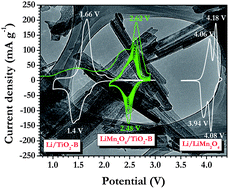Extraordinary long-term cycleability of TiO2-B nanorods as anodes in full-cell assembly with electrospun PVdF-HFP membranes†
Abstract
One dimensional TiO2-B

* Corresponding authors
a
Energy Research Institute@NTU (ERI@N), Nanyang Technological University, Research Techno Plaza, 50 Nanyang Drive, Singapore 637553, Singapore
E-mail:
aravind_van@yahoo.com
b
School of Materials Science and Engineering, Nanyang Technological University, Singapore 639798, Singapore
E-mail:
Madhavi@ntu.edu.sg
Fax: +65 6790 9081
Tel: +65 6790 4606
One dimensional TiO2-B

 Please wait while we load your content...
Something went wrong. Try again?
Please wait while we load your content...
Something went wrong. Try again?
V. Aravindan, N. Shubha, Y. L. Cheah, R. Prasanth, W. Chuiling, R. R. Prabhakar and S. Madhavi, J. Mater. Chem. A, 2013, 1, 308 DOI: 10.1039/C2TA00078D
To request permission to reproduce material from this article, please go to the Copyright Clearance Center request page.
If you are an author contributing to an RSC publication, you do not need to request permission provided correct acknowledgement is given.
If you are the author of this article, you do not need to request permission to reproduce figures and diagrams provided correct acknowledgement is given. If you want to reproduce the whole article in a third-party publication (excluding your thesis/dissertation for which permission is not required) please go to the Copyright Clearance Center request page.
Read more about how to correctly acknowledge RSC content.
 Fetching data from CrossRef.
Fetching data from CrossRef.
This may take some time to load.
Loading related content
